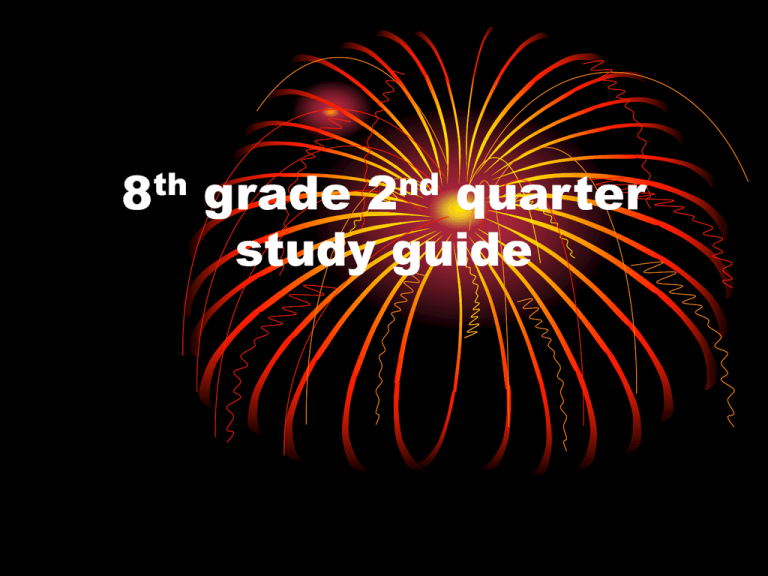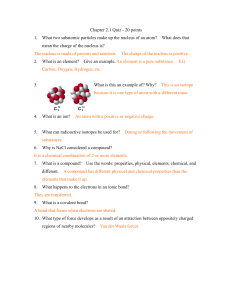8th grade 2nd quarter study guide
advertisement

th 8 nd 2 grade quarter study guide 1. This happens when chemical bonds break and new bonds form? A. a physical change B. a chemical reaction C. matter is destroyed D. surface area increases 2. The atomic number of an element is based on the A.mass of its nucleus. B.number of electrons around its core. C.number of protons in its nucleus. D.number of neutrons in its nucleus. 3. Which process is an example of a physical change? • A. paper burning • B iron rusting • C dissolving salt in water • D milk souring 4. Which group of elements shares characteristics with both metals and nonmetals? A.salts B.metalloids C.halogens D.alloys 5. A solid that forms from solution during a chemical reaction is called a(n) A. element. B. bond. C. mixture. D. precipitate. 6. A chemical reaction that absorbs energy in the form of heat is described as A. endothermic. B. exothermic. C. combustion. D. unbalanced. 7. The simplest type of substance that cannot be broken down into any other substance is a(n) A. precipitate. B. compound. C. mixture. D. element. 8. When an atom loses an electron, it becomes a A. positive ion. B. negative ion. C. neutral ion. D. neutral atom. 9. A chemical bond formed when two atoms share electrons is called a(n) A. ionic bond. B. covalent bond. C. polyatomic bond. D. crystal bond 10. According to the Law of Conservation of Mass, when Hydrogen and oxygen combine chemically, the mass of the product is A.greater than the mass of the hydrogen plus the mass of the oxygen B. equal to the mass of the hydrogen plus the mass of the oxygen C. equal to the mass of the hydrogen D. less than the mass of the hydrogen 11. The substances listed on the left side of a chemical equation are the A. products. B. coefficients. C. precipitates. D. reactants. 12. Which particles in an atom are in the nucleus? A. protons and neutrons B. protons and electrons C. protons and ions D. electrons and neutrons 13. Electrons involved in bonding between atoms are A. valence electrons. B. inside the nucleus. C. closest to the nucleus. D. positively charged. 14 What is the chemical name for the compound with the formula Li2S? A. Lithium Sulfur B. Sulfur Lithide C. lithium sulfide D. sodium sulfide 15. The atomic number is the number of A. protons in the nucleus of an atom. B. neutrons in the nucleus of an atom. C. valence electrons in an atom. D. electrons in the nucleus of an 16. Which of these particles has a positive charge? A. atom B. proton C. neutron D. electron 17. An ionic bond is the attraction between A. similarly charged ions. B. oppositely charged ions. C. neutral ions. D. neutral atoms. 18.Fill in the chart Substance Atomic Number Atomic Mass Beryllium Potassium 19 Calcium 20 Phosphorus Protons Neutrons 4 5 39 19 20 31 Electrons 15 20 20 15 Use this periodic table to answer the following questions. 19. Which elements have one valence electrons in their atoms? A. transition metals B. metal alloys C. alkaline earth metals D. alkali metals 20. In an electron dot diagram of Boron(B), how many dots should be drawn around the element’s symbol? A. 1 B. 13 C. 5 D. 3 21.How many atoms of a Oxygen(O) would be needed to react with one atom of a Magnesium (Mg) element, in order to form an ionic compound? A. 1 B. 3 C. 2 22. Fluorine(F), chlorine(Cl), bromine(Br), and iodine(I) are part of a family called A. noble gases. B. metalloids. C. halogens. D. alkali metals. Balance the equations • Cl2 + NaBr • H2 + N2 • Na + Br2 NaCl + Br2 NH3 NaBr 1. This happens when chemical bonds break and new bonds form? A. a physical change B. a chemical reaction C. matter is destroyed D. surface area increases 2. The atomic number of an element is based on the A.mass of its nucleus. B.number of electrons around its core. C.number of protons in its nucleus. D.number of neutrons in its nucleus. 3. Which process is an example of a physical change? • A. paper burning • B iron rusting • C dissolving salt in water • D milk souring 4. Which group of elements shares characteristics with both metals and nonmetals? A.salts B.metalloids C.halogens D.alloys 5. A solid that forms from solution during a chemical reaction is called a(n) A. element. B. bond. C. mixture. D. precipitate. 6. A chemical reaction that absorbs energy in the form of heat is described as A. endothermic. B. exothermic. C. combustion. D. unbalanced. 7. The simplest type of substance that cannot be broken down into any other substance is a(n) A. precipitate. B. compound. C. mixture. D. element. 8. When an atom loses an electron, it becomes a A. positive ion. B. negative ion. C. neutral ion. D. neutral atom. 9. A chemical bond formed when two atoms share electrons is called a(n) A. ionic bond. B. covalent bond. C. polyatomic bond. D. crystal bond 10. According to the Law of Conservation of Mass, when Hydrogen and oxygen combine chemically, the mass of the product is A.greater than the mass of the hydrogen plus the mass of the oxygen B. equal to the mass of the hydrogen plus the mass of the oxygen C. equal to the mass of the hydrogen D. less than the mass of the hydrogen 11. The substances listed on the left side of a chemical equation are the A. products. B. coefficients. C. precipitates. D. reactants. 12. Which particles in an atom are in the nucleus? A. protons and neutrons B. protons and electrons C. protons and ions D. electrons and neutrons 13. Electrons involved in bonding between atoms are A. valence electrons. B. inside the nucleus. C. closest to the nucleus. D. positively charged. 14 What is the chemical name for the compound with the formula Li2S? A. Lithium Sulfur B. Sulfur Lithide C. lithium sulfide D. sodium sulfide 15. The atomic number is the number of A. protons in the nucleus of an atom. B. neutrons in the nucleus of an atom. C. valence electrons in an atom. D. electrons in the nucleus of an atom. 16. Which of these particles has a positive charge? A. atom B. proton C. neutron D. electron 17. An ionic bond is the attraction between A. similarly charged ions. B. oppositely charged ions. C. neutral ions. D. neutral atoms. 18.Fill in the chart Substance Atomic Number Atomic Mass Protons Neutrons Electrons Beryllium 4 9 4 5 4 Potassium 19 39 19 20 19 Calcium 20 40 20 20 20 Phosphorus 15 31 15 16 15 Use this periodic table to answer the following questions. 19. Which elements have one valence electrons in their atoms? A. transition metals B. metal alloys C. alkaline earth metals D. alkali metals 20. In an electron dot diagram of Boron(B), how many dots should be drawn around the element’s symbol? A. 1 B. 13 C. 5 D. 3 21.How many atoms of a Oxygen(O) would be needed to react with one atom of a Magnesium (Mg) element, in order to form an ionic compound? A. 1 B. 3 C. 2 D. 4 22. Fluorine(F), chlorine(Cl), bromine(Br), and iodine(I) are part of a family called A. noble gases. B. metalloids. C. halogens. D. alkali metals. Balance the equations • Cl2 + NaBr • H2 + N2 • Na + Br2 NaCl + Br2 NH3 NaBr Balance the equations • Cl2 + 2NaBr • 3H2 + N2 • 2Na + Br2 2 NaCl + Br2 2NH3 2NaBr






